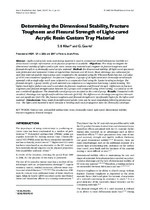| dc.contributor.author | Khan, Saadika | |
| dc.contributor.author | Geerts, Greta VM | |
| dc.date.accessioned | 2020-10-30T08:51:52Z | |
| dc.date.available | 2020-10-30T08:51:52Z | |
| dc.date.issued | 2009-06 | |
| dc.identifier.citation | Khan SB, Geerts G. Determining the Dimensional Stability, Fracture Toughness and Flexural Strength of Light-cured Acrylic Resin Custom Tray Material. Eur. J. Prosthont. Rest. Dent. Vol 17, No. 2, pp 67-72 | en_US |
| dc.identifier.issn | 0965-7452 | |
| dc.identifier.uri | http://hdl.handle.net/10566/5319 | |
| dc.description | N/A | en_US |
| dc.description.abstract | Light-cured acrylic resin custom tray material is used in commercial dental laboratories but little evidence-
based scientific information on its physical properties is available. Objectives: This study investigates the
dimensional stability of light-cured acrylic resin custom tray material and compares its fracture toughness and
flexural strength to a chemically-cured acrylic material. Method: For dimensional stability, 20 light-cured specimens
were fabricated and measured 3 times at regular time intervals over 48 hours. Mean shrinkage was calculated for
each time interval and the mean values were compared to the standard using the Wilcoxon Rank Sum test. A p-value
of <0.05 was considered significant. For fracture toughness, 2 groups of 20 light-cured and chemically-cured acrylic
materials with a single-edge notch were subjected to a compressive load using the 3-point bending technique. For
flexural strength, 1 group (n=20) of each material was subjected to a compressive load using 3-point bending. The
highest load before failure was used to calculate the fracture toughness and flexural strength. Differences in fracture
toughness and flexural strength values between the 2 groups were compared using ANOVA testing. A p-value of <0.05
was considered significant. The chemically-cured group was accepted as the control group. Results: Compared to the
standard, shrinkage was significant for all time intervals (p<0.05). The difference in shrinkage among time intervals
was not significant (p>0.05). The fracture toughness and flexural strength were significantly higher for the light-cured
material. Conclusions: Trays made from light-cured acrylic resin can be used immediately following polymerization.
The light-cured material is more resistant to bending and crack propagation than the chemically-cured type. | en_US |
| dc.description.sponsorship | Megadent for donating materials. | en_US |
| dc.language.iso | en | en_US |
| dc.publisher | European Journal of Prosthodontics and Restorative Dentistry | en_US |
| dc.relation.ispartofseries | 17;2 | |
| dc.subject | Custom tray, polymethyl methacrylate resin, chemically-cured, light-cured, dimensional stability, fracture toughness, flexural strength | en_US |
| dc.title | Determining the Dimensional Stability, Fracture Toughness and Flexural Strength of Light-cured Acrylic Resin Custom Tray Material | en_US |
| dc.type | Article | en_US |

